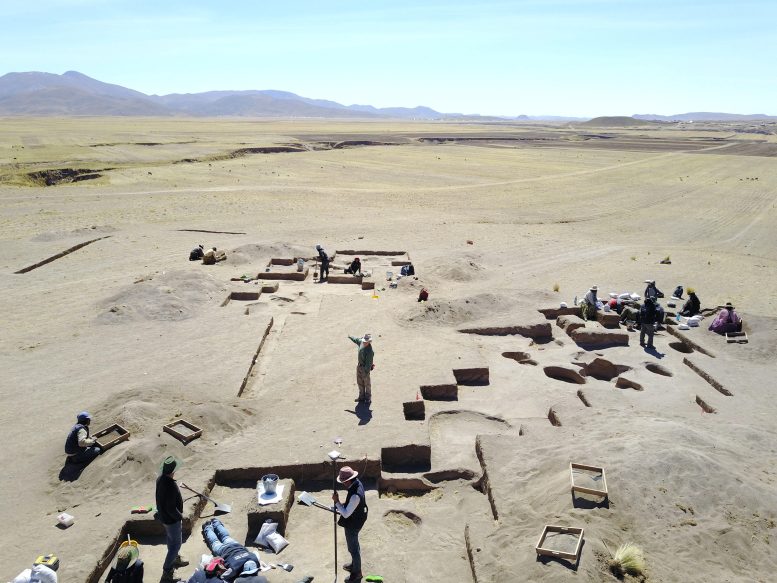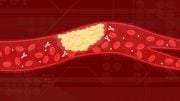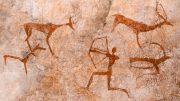
Recent research challenges the traditional view of early human diets in the Andes, suggesting a shift from “hunter-gatherers” to “gatherer-hunters.” The study, analyzing remains from the Wilamaya Patjxa and Soro Mik’aya Patjxa sites in Peru, reveals an 80 percent plant-based and 20 percent meat diet among early Andeans. This finding, based on isotope chemistry and statistical modeling, contradicts previous beliefs and influences current perceptions of diets such as the Paleodiet. It also indicates a need to reassess archaeological frameworks globally.
The commonly used term “hunter-gatherers” for describing early humans should be revised to “gatherer-hunters” in the context of the Andes in South America, suggests groundbreaking new research led by an archaeologist from the University of Wyoming.
Archaeologists long thought that early human diets were meat-based. However, Assistant Professor Randy Haas’ analysis of the remains of 24 individuals from the Wilamaya Patjxa and Soro Mik’aya Patjxa burial sites in Peru shows that early human diets in the Andes Mountains were composed of 80 percent plant matter and 20 percent meat.
The study was recently published in the peer-reviewed journal PLOS ONE. It applies methods in isotope chemistry and statistical modeling to unveil a surprising twist in early Andean societies and traditional hunter-gatherer narratives.
“Conventional wisdom holds that early human economies focused on hunting — an idea that has led to a number of high-protein dietary fads such as the Paleodiet,” Haas says. “Our analysis shows that the diets were composed of 80 percent plant matter and 20 percent meat.”
Evidence of Plant-Dominant Diets
For these early humans of the Andes, spanning from 9,000 to 6,500 years ago, there is indeed evidence that hunting of large mammals provided some of their diets. But the new analysis of the isotopic composition of the human bones shows that plant foods made up the majority of individual diets, with meat playing a secondary role.

The Wilamaya Patjxa archeological site in Peru produced human remains showing that the diets of early people of the Andes were primarily composed of plant materials. Credit: Randy Haas
Additionally, burnt plant remains from the sites and distinct dental-wear patterns on the individuals’ upper incisors indicate that tubers — or plants that grow underground, such as potatoes — likely were the most prominent subsistence resource.
Multidisciplinary Research and Student Involvement
“Our combination of isotope chemistry, paleoethnobotanical, and zooarchaeological methods offers the clearest and most accurate picture of early Andean diets to date,” Haas says. “These findings update our understanding of earliest forager economies and the pathway to agricultural economies in the Andean highlands.”
Joining Haas in the study were researchers from Penn State University, the University of California-Merced, the University of California-Davis, Binghamton University, the University of Arizona, and the National Register of Peruvian Archaeologists.
Undergraduate students also had the opportunity to conduct research during the initial 2018 excavations at the Wilamaya Patjxa burial site.
Currently a Ph.D. student in anthropology at Penn State University, Jennifer Chen, the journal article’s lead author and a former undergraduate student in Haas’ research lab, performed the isotope lab work and much of the isotope analysis following the excavations.
“Food is incredibly important and crucial for survival, especially in high-altitude environments like the Andes,” Chen says. “A lot of archaeological frameworks on hunter-gatherers, or foragers, center on hunting and meat-heavy diets — but we are finding that early hunter-gatherers in the Andes were mostly eating plant foods like wild tubers.”
Haas notes that archaeologists now have the tools to understand early human diets, and their results are not what they anticipated. This case study demonstrates for the first time that early human economies, in at least one part of the world, were plant-based.
“Given that archaeological biases have long misled archaeologists — myself included — in the Andes, it is likely that future isotopic research in other parts of the world will similarly show that archaeologists have also gotten it wrong elsewhere,” he says.
Haas investigates human behavior in forager societies of the past to better understand human behavior in the present. He leads archaeological excavations and survey projects in the Andes and mountain regions of western North America.
Reference: “Stable isotope chemistry reveals plant-dominant diet among early foragers on the Andean Altiplano, 9.0–6.5 cal. ka” by Jennifer C. Chen, Mark S. Aldenderfer, Jelmer W. Eerkens, BrieAnna S. Langlie, Carlos Viviano Llave, James T. Watson and Randall Haas, 24 January 2024, PLOS ONE.
DOI: 10.1371/journal.pone.0296420









So, one relatively small region (with a rather distinctly non-normal environment) is sufficient to extrapolate to all of Earth’s regions and the humanity living in them??
talk about junk science.
Obviously the Andean environment was identical to the rest of the world.
Eiford,That’s why these new technologies were developed. Work will have to be done world wide to see if this is just a local development, or more general world wide.You should have already realized that.
Did they also have rotten disfigured teeth and stunted growth bones like ancient Egyptian mummies? Serious question.
… click bait
After 11 years of reading dietary research as a hobby, it is always the plant based dogma followers that howl the loudest at the smallest piece of circumstantial evidence. Would I agree ancient andean people would have lived on the potato? Well duh, where do you think the potato came from?
There isn’t limited evidence for this. This is a new piece of evidence that just yet again confirms what we have known for centuries. Your 11 years of reading as a hobby does not invalidate centuries of scientific understanding.
The stable isotope record clearly shows that we have been primarily meat eaters for the overwhelming majority of our history. “Centuries of scientific understanding” is a statement that only someone who doesn’t understand science would say. Science, ethical science, is supposed to try to prove itself wrong. This article is truly junk science.
More propaganda to get men to stop eating meat and to get everyone onto the WEF bugs/soy diet.
Chemical castration through diet is how they are trying to get you. Dont fall for the lies.
Diese,This article is a commentary on work done in the South America using new technologies to determine what the diet of the local population looked like in the past. not an indictment against meat eaters.your attempt to somehow turn this political is amusing and stupid.
We have known humans, as with the other apes, were and are plant based for centuries now. Meat and other animal products should only be around 30% if your diet at most. 20-25% ideally. Americans and Europeans eat too much meat as it is now and that is harming men far more than any new scientific diacovery of our ancestors is.
Depending on which species monkey or ape we are talking about, they can also digest sticks, bark and their own feces.
As the meat industry (and big pharma that supports it) fights to save its stock values and income, I can hear the clicks of their hired keyboard warriors trying to take this study down. With the latest research showing plant polyphenols attach to cell receptors that literally keep us healthy, it’s just a matter of time before high meat intake goes the way of the dinosaurs. Don’t blindly accept carnivore propaganda – do your own research and ONLY listen to findings from peer-reviewed studies, your heart and brain will thank you for it. Neurogenesis anyone?
Humans evolved on mostly meat, as did the andeans before agriculture. No one argues some humans moved to agriculture 10-12 thousand years ago, but they also lost 5 inches in height and 15% lower brain size.
Good article
Excellent info,,dont knock it until you try it.,,
Remember the length of our intestinal track.,,its delicious to eat vegan all day long,,hay house publ.,
Plants as seasonal harbingers
Maple sugar now
Humans are omnivores. We cannot digest cellulose. We thrive on animal fats and proteins. Plants contain many anti nutrients that strip your body of nutrients. Vegans are beta wimps. We don’t have six stomachs like a cow does.
“Early humans” means 6000-9000 years ago to these “scientists”. And a few of them in the Andes had easier access to tuber veggies than meat, so they ate them more than meat, and that means all “early humans” were primarily vegetarians. Crap like this makes you wonder if anything we know about the past is true at all.
Fred that is not what the article is saying.when new information is discovered using new technologies. It’s time to reexamine old ideas after something unexpected is discovered, using the new technologies. Your black and white thinking tells me your not a scientist..
What’s your definition of plant based. 20% of dietary nutrients from animal sources is 400 calories of a modern 2000 calorie diet.That is 2 to 3 servings of lean animal protein. That’s the recommended amount of daily animal protein.
A better article title would be, ancient nuitrition is on par with the American heart association recommended servings….
Yes the article clearly states ‘6000 to 9000 years ago’
Vegetables and grains as we know them today are less than 200 years old. We lost the ability to digest cellulose millions of years ago. There are essential amino acids and essential fatty acids but zero essential carbohydrates. I personally was diagnosed type 2 diabetic a few years ago and reversed it going Keto. I barely touch any plant matter and eat less than 30 barbs a day. I’m in my 60s and never felt better. Our big brain is due to diet and it shrunk 10% when agriculture began.
You are the exception and not the rule. Diabetes is a defect that would have been killed off if we did not have the medical understanding and technology to handle it. This same sentiment applies to different intolerances. No primates can digest cellulose and we do not need to. A proper diet should be only around 20-25% meat and animal product. 30% is the highest that could be argued. Humans have and will always eat mostly plants. That is just a fact.
This is shameful. The author of this article should be ashamed.
People eat what is available. It is hardly ground breaking to find that in the Andes where there are few animals they are mostly plants. Ancient Arctic people are almost entirely flesh and fat. Neither case says anything about humans in general.
I do paleoecological reconstruction with our ancestors. I look for and identify stable isotopes to understand the diet patterns of them and other animals based on jaws, skulls, and entire skeletons. When I find stable isotopes, that tells me what the climate was like and what they were eating. I can confirm this based on tooth wear and their skeletal and jaw structure. I can also confirm by looking at today’s ecosystem to see what lives there and running it by people who study that area today.
One of the oldest human family tree inhabitants is Sahelanthropus tchadensis. This is also thought to be our common ancestor with chimps, but I won’t fully go into that. They had a plant based diet for the most part, and as we get later in our history, we see our ancestors become more generalist, eating small mammals, lizards, and insects. The first we see of widespread human meat eating is in the archeological record with H. habilis, the first member of our genus. Not the Ardipithecines and not the Australopithecines. The Robust Australopithecines are actually hyperspecialized for eating fiberous and tough plants. They are called robust because of their jaws. Anyways, H. habilis had a diet that was versatile and they were able to eat a range of foods, including tougher foods like leaves, woody plants, and some animal tissues, but that they did not routinely consume or specialize in eating hard foods like brittle nuts, seeds, dried meat, or tubers that were harder. The animal tissues they ate would have been small ammounts of marrow and muscles.
The proportions of our bodies today are a product of millions of years of evolution, and H. erectus is the one who first evolved a narrower ribcage and pelvis, shorter large intestines, and longer small intestines like we see today. The tall bodies and large brains of H. erectus individuals required a lot of energy on a regular basis to function, so eating meat and other types of protein that could be quickly digested made it possible to absorb nutrients with a shorter digestive tract, making more energy available faster. Honey and hard tubers likely would have been significant food sources for erectus as they were abundant and easy energy sources. This made the early human gut smaller, and it decreased the time it took to digest food to gain its energy. Finally, we get to H. heidelbergensis, where we first see big game hunting and meat being incorporated as a bigger part of the overall diet as they went farther north and into colder environments. Eating a considerable amount of meat is therefore relatively new to us as a species. Even when we started practicing agriculture, meat was still only a fraction of our diet.
We are omnivores, generalists who can adapt to various environmental needs. That’s what most primates do. We eat both plants and animals and are generally omnivores. Some, like baboons, eat mostly meat, and some like gorillas eat mostly plants, but either way, they can still eat anything and are able to survive without one or the other. If we look at our closest relatives alive today, the Panins (Chimps and Bonobos), they regularly hunt smaller animals but continue to survive on mostly plants. Even if we didn’t have vast amounts of fossil evidence, genetic evidence, and even just visual and cultural evidence, looking at our recent relatives of the last few thousand years tells us that most of our diet should be from plants. Root, stem, leaf, and flowering vegetables. Fruits are another important part of plants, but overall vegetables should be your main plant source. Our ancestors have always eaten every part of plants. Meat is something that can be about a quarter of your diet or maybe a third. This is what the evidence tells us. We have never been carnivores.
Apologies. That reply was to somebody else.
Can you elaborate more how to conclude the 1/4 to 1/3 meat diet is ideal?
Prior to the mrgafauna extinction event, 12,800 BP, there is zero nitrogen isotope evidence that diets were plant based. All the evidence is for Meat Based diet. This article is completely misleading at best. I am 70 and have completely reversed my pre-diabetes with keto-carno. Plants are full of toxins. I don’t eat them anymore. THW Klaus Schwab and company.
I do paleoecological reconstruction with our ancestors. I look for and identify stable isotopes to understand the diet patterns of them and other animals based on jaws, skulls, and entire skeletons. When I find stable isotopes, that tells me what the climate was like and what they were eating. I can confirm this based on tooth wear and their skeletal and jaw structure. I can also confirm by looking at today’s ecosystem to see what lives there and running it by people who study that area today.
One of the oldest human family tree inhabitants is Sahelanthropus tchadensis. This is also thought to be our common ancestor with chimps, but I won’t fully go into that. They had a plant based diet for the most part, and as we get later in our history, we see our ancestors become more generalist, eating small mammals, lizards, and insects. The first we see of widespread human meat eating is in the archeological record with H. habilis, the first member of our genus. Not the Ardipithecines and not the Australopithecines. The Robust Australopithecines are actually hyperspecialized for eating fiberous and tough plants. They are called robust because of their jaws. Anyways, H. habilis had a diet that was versatile and they were able to eat a range of foods, including tougher foods like leaves, woody plants, and some animal tissues, but that they did not routinely consume or specialize in eating hard foods like brittle nuts, seeds, dried meat, or tubers that were harder. The animal tissues they ate would have been small ammounts of marrow and muscles.
The proportions of our bodies today are a product of millions of years of evolution, and H. erectus is the one who first evolved a narrower ribcage and pelvis, shorter large intestines, and longer small intestines like we see today. The tall bodies and large brains of H. erectus individuals required a lot of energy on a regular basis to function, so eating meat and other types of protein that could be quickly digested made it possible to absorb nutrients with a shorter digestive tract, making more energy available faster. Honey and hard tubers likely would have been significant food sources for erectus as they were abundant and easy energy sources. This made the early human gut smaller, and it decreased the time it took to digest food to gain its energy. Finally, we get to H. heidelbergensis, where we first see big game hunting and meat being incorporated as a bigger part of the overall diet as they went farther north and into colder environments. Eating a considerable amount of meat is therefore relatively new to us as a species. Even when we started practicing agriculture, meat was still only a fraction of our diet.
We are omnivores, generalists who can adapt to various environmental needs. That’s what most primates do. We eat both plants and animals and are generally omnivores. Some, like baboons, eat mostly meat, and some like gorillas eat mostly plants, but either way, they can still eat anything and are able to survive without one or the other. If we look at our closest relatives alive today, the Panins (Chimps and Bonobos), they regularly hunt smaller animals but continue to survive on mostly plants. Even if we didn’t have vast amounts of fossil evidence, genetic evidence, and even just visual and cultural evidence,looking at our recent relatives of the last few thousand years tells us that most of our diet should be from plants. Root, stem, leaf, and flowering vegetables. Fruits are another important part of plants, but overall vegetables should be your main plant source. Our ancestors have always eaten every part of plants. Meat is something that can be about a quarter of your diet or maybe a third. This is what the evidence tells us. We have never been carnivores.
Funny that hundreds of thousands of people moving to a carnivore diet have cured lifelong ailments by eliminating plants.
The word of God tells us that all humans and animals were plant-based eaters until the flood of Noah’s time after which because everything was flooded and not growing God told Noah he could eat meat. This is not scientific this is the truth of God’s word which we are very fortunate to have provided to us by a good father.
Assuming the methodology proves what the authors say it does about the dietary composition of the Andeans they examined, it would suggest that ancient peoples in environments with relatively little meat available ate relatively little meat. Who’d have imagined …
Did you do the math. 20% is literally the recommended guidelines from the American heart association. 2-3 servings of lean protein a day which prior to domestication was probably most of our protein. That is also based off of 2000 calories which was probably to little for their activity. No one would call that plant based. It’s a true omnivore diet. The author just push what he wanted people to hear.
Humans evolved on mostly meat, as did the andeans before agriculture. No one argues some humans moved to agriculture 10-12 thousand years ago, but they also lost 5 inches in height and 15% lower brain size.
This article is not based on actual science. The left needs to quit trying to rewrite science and history.
It’s not a left right thing, it’s big AG vs the meat industry.
80% of weight volume or calories?
The only person to pick up on the actual facts and not the sensationalized tone and title.
So a better title would be, people in the Andes ate what the American heart association and the Mediterranean diet have recommended for years. Mostly plants and 2 to 3 servings of lean protein.
The use of the word “early” is completely unethical. 10,000 years ago for a species that is at least 200,000 years old is “recent”. And that is recent enough to involve some kind of agriculture. The basic proof that humans are primarily meat eaters is the lack of reliability of plants for most of our history. Before agriculture, once a plant was eaten, it was gone. Which means finding another plant. The only thing constantly available was meat.
That’s exactly what the Bible says.
Before the flood humans were vegetarian.
What vegitarian eats 400 calories of animal protein a day…
Because that’s what the article says. 20% of Andes diet was animal protein.
Remember the length of our intestinal tract??
This is complete bunk which is debunked by our intenstinal ratios, lack of a cecum, dention, brain size, shoulder development, etc. Humans were and ARE hyper-carnivores. Trying to push a narrative does nothing to change the truth.
We’re omnivores.
Only junk science would call humans from 6000-9500 years ago “early humans.” Those are recent humans, folks. And shocker, once the mega fauna were killed off by catastrophic floods roughly 11,000 to 12,000 years ago, humans were forced to try to survive on sub-optimal food sources like plants. Humans are apex predators and therefore carnivores. The only thing modern humans need to learn is to treat our animals humanely, and our/their environment sustainably, so that they live healthy lives thereby providing us with healthy food.
There was never a flood, science has proven this time and time again. Quit believing in fairytales.
Humans evolved on mostly meat, as did the andeans before agriculture. No one argues some humans moved to agriculture 10-12 thousand years ago, but they also lost 5 inches in height and 15% lower brain size.
It seems that the people responding and comment here are actually more intelligent than the author of the article.
Lol. No. We are meat eaters, always have been. Our brains shrunk when we started setting plants. This is more BS science paid for by the sugar and pharma industry. Humans are Carnivores .
Have you seen people from the Andes? Tiny, and weak. That should be a clue that small subset of humans were eating the wrong stuff. My people the Cherokee and Choctaw mostly ate meat, and were much stronger. I’m a carnivore and have lost over 150 lbs, no longer take a handful of pills, cured my diabetes arthritis gout and kidney stones. The natural human diet for truly ancient humans is obviously meat. Stop doing the bidding of big AG and the sugar industry.
Total clickbait.
1. This occurs at the end of the Neolithic revolution… many cultures around the world were settling into permanent residences growing various crops.
2. Go prior to the Neolithic period and it’s millions of years of fatty meat.
3. An abundance of plants is relatively new to the human diet.
Our stomach acid has ph of 1.5,
We are scavenger/ carnivores.
We can’t digest fiber.
No Cecum.
Pants on head re****ed.
“9000 to 6000 years ago” … this is not early humans. It corresponds to the advent of agriculture in other parts of the world. It’s a blip in evolutionary time. It’s already been shown through isotope analysis that humans ate largely meat based diets with some tubers way before this.
“Early humans”? =))) that was already after agriculture was discovered, humans ate a heavy meat based diets for millions of years before that.